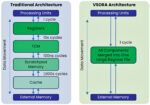You are currently viewing SemiWiki as a guest which gives you limited access to the site. To view blog comments and experience other SemiWiki features you must be a registered member. Registration is fast, simple, and absolutely free so please,
join our community today!
The competitive landscape of hardware-assisted verification (HAV) has evolved dramatically over the past decade. The strategic drivers that once defined the market have shifted in step with the rapidly changing dynamics of semiconductor design.
Design complexity has soared, with modern SoCs now integrating tens of billions… Read More
VSORA, a pioneering high-tech company, has engineered a novel architecture designed specifically to meet the stringent demands of AI inference—both in datacenters and at the edge. With near-theoretical performance in latency, throughput, and energy efficiency, VSORA’s architecture breaks away from legacy designs optimized… Read More
Recently, I had the opportunity to speak with Synopsys’ distinguished experts in speed adapters and in-circuit emulation (ICE). Many who know my professional background see me as an advocate for virtual, transactor-based emulation, hence I was genuinely surprised to discover the impressive results achieved by today’s speed… Read More
Introduction: The Historical Roots of Hardware-Assisted Verification
The relentless pace of semiconductor innovation continues to follow an unstoppable trend: the exponential growth of transistor density within a given silicon area. This abundance of available semiconductor fabric has fueled the creativity of design… Read More
Since the fall of the Roman Empire, France has played a defining role in shaping Western civilization. In the 9th century, Charlemagne—a Frank—united much of Europe under one rule, leaving behind a legacy so profound he is still remembered as the “Father of Europe.” While Italy ignited the Renaissance, it was 16th-century France… Read More
Rick Carlson, Verific Design Automation’s Vice President of Sales, is an EDA trends spotter. I was reminded of his prescience when he recently called to catch up and talk about Verific’s role as provider of front-end platforms powering an emerging EDA market.
Verific, he said, is joining forces with a group of well-funded startups… Read More
Part 2 examines the transformation of the interface protocols industry from a fragmented market of numerous specialized vendors to a more consolidated one dominated by a few major solutions providers as driven by the increasing complexity of modern protocols. It highlights the importance of rigorous validation of interface… Read More
Prolog – Interface Protocols: Achilles’ Heels in Today’s State-of-the-art SOCs
June 30 was only a week away when Varun had a sleepless night. The call from the datacenter manager the evening before alerted him on a potential problem with the training of a new Generative AI model. Six months earlier Varun’s employer installed… Read More
VSORA AI Processor Raises $46 Million to Fast-Track Silicon Development
We stand on the cusp of an era defined by ubiquitous intelligence—a stone’s throw from a tidal wave of AI-powered products underpinned by next-generation silicon. Realizing that future demands nothing less than a fundamental rethink of how we design semiconductors… Read More
At this year’s SNUG (Synopsys Users Group) conference, Richard Ho, Head of Hardware, OpenAI, delivered the second keynote, titled “Scaling Compute for the Age of Intelligence.” In his presentation, Richard guided the audience through the transformative trends and implications of the intelligence era now unfolding before… Read More
















The Quantum Threat: Why Industrial Control Systems Must Be Ready and How PQShield Is Leading the Defense